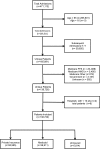The effect of insurance status on mortality and procedural use in critically ill patients
- PMID: 21700910
- PMCID: PMC3208649
- DOI: 10.1164/rccm.201101-0089OC
The effect of insurance status on mortality and procedural use in critically ill patients
Abstract
Rationale: Lack of health insurance maybe an independent risk factor for mortality and differential treatment in critical illness.
Objectives: To determine whether uninsured critically ill patients had differences in 30-day mortality and critical care service use compared with those with private insurance and to determine if outcome variability could be attributed to patient-level or hospital-level effects.
Methods: Retrospective cohort study using Pennsylvania hospital discharge data with detailed clinical risk adjustment, from fiscal years 2005 and 2006, consisting of 167 general acute care hospitals, with 138,720 critically ill adult patients 64 years of age or younger.
Measurements and main results: Measurements were 30-day mortality and receipt of five critical care procedures. Uninsured patients had an absolute 30-day mortality of 5.7%, compared with 4.6% for those with private insurance and 6.4% for those with Medicaid. Increased 30-day mortality among uninsured patients persisted after adjustment for patient characteristics (odds ratio [OR], 1.25 for uninsured vs. insured; 95% confidence interval [CI], 1.04–1.50) and hospital-level effects (OR, 1.26; 95% CI, 1.05–1.51). Compared with insured patients, uninsured patients had decreased risk-adjusted odds of receiving a central venous catheter (OR, 0.84; 95% CI,0.72–0.97), acute hemodialysis (OR, 0.59; 95% CI, 0.39–0.91), and tracheostomy (OR, 0.43; 95% CI, 0.29–0.64).
Conclusions: Lack of health insurance is associated with increased 30-day mortality and decreased use of common procedures for the critically ill in Pennsylvania. Differences were not attributable to hospital-level effects, suggesting that the uninsured have a higher mortality and receive fewer procedures when compared with privately insured patients treated at the same hospitals.
Figures
Comment in
-
The effect of insurance status on mortality and procedure use in critically ill patients: an object lesson in financial incentives.Am J Respir Crit Care Med. 2011 Oct 1;184(7):750-1. doi: 10.1164/rccm.201107-1347ED. Am J Respir Crit Care Med. 2011. PMID: 21965010 No abstract available.
Similar articles
-
Not All Insurance Is Equal: Differential Treatment and Health Outcomes by Insurance Coverage Among Nonelderly Adult Patients With Heart Attack.J Am Heart Assoc. 2018 Jun 5;7(11):e008152. doi: 10.1161/JAHA.117.008152. J Am Heart Assoc. 2018. PMID: 29871858 Free PMC article.
-
The association of lacking insurance with outcomes of severe sepsis: retrospective analysis of an administrative database*.Crit Care Med. 2014 Mar;42(3):583-91. doi: 10.1097/01.ccm.0000435667.15070.9c. Crit Care Med. 2014. PMID: 24152590 Free PMC article.
-
Insurance and racial differences in long-term acute care utilization after critical illness.Crit Care Med. 2012 Apr;40(4):1143-9. doi: 10.1097/CCM.0b013e318237706b. Crit Care Med. 2012. PMID: 22020247
-
Caesarean section in uninsured women in the USA: systematic review and meta-analysis.BMJ Open. 2019 Mar 3;9(3):e025356. doi: 10.1136/bmjopen-2018-025356. BMJ Open. 2019. PMID: 30833323 Free PMC article.
-
Disparities in Access, Management and Outcomes of Critically Ill Adult Patients with Trauma.Crit Care Clin. 2024 Oct;40(4):659-670. doi: 10.1016/j.ccc.2024.05.003. Epub 2024 Jun 6. Crit Care Clin. 2024. PMID: 39218479 Review.
Cited by
-
Associations between dementia diagnosis and end-of-life care utilization.J Am Geriatr Soc. 2022 Oct;70(10):2871-2883. doi: 10.1111/jgs.17952. Epub 2022 Jul 13. J Am Geriatr Soc. 2022. PMID: 35822659 Free PMC article.
-
Healthcare disparities in critical illness.Crit Care Med. 2013 Dec;41(12):2784-93. doi: 10.1097/CCM.0b013e3182a84a43. Crit Care Med. 2013. PMID: 24121467 Free PMC article. Review.
-
Outcomes of Patients With Primary Cardiac Diagnoses Admitted to Cardiac vs Noncardiac Intensive Care Units.JACC Adv. 2022 Oct;1(4):100114. doi: 10.1016/j.jacadv.2022.100114. Epub 2022 Oct 28. JACC Adv. 2022. PMID: 36466046 Free PMC article.
-
The effect of insurance status on outcomes after laparoscopic cholecystectomy.Surg Endosc. 2013 May;27(5):1761-5. doi: 10.1007/s00464-012-2675-8. Epub 2012 Dec 18. Surg Endosc. 2013. PMID: 23247740
-
Survival after acute hemodialysis in Pennsylvania, 2005-2007: a retrospective cohort study.PLoS One. 2014 Aug 20;9(8):e105083. doi: 10.1371/journal.pone.0105083. eCollection 2014. PLoS One. 2014. PMID: 25141028 Free PMC article.
References
-
- Fowler RA, Noyahr LA, Thornton JD, Pinto R, Kahn JM, Adhikari NK, Dodek PM, Khan NA, Kalb T, Hill A, et al. An official American Thoracic Society systematic review: the association between health insurance status and access, care delivery, and outcomes for patients who are critically ill. Am J Respir Crit Care Med. 2010;181:1003–1011 - PMC - PubMed
-
- DeNavas-Walt CPB, Smith JC, US Census Bureau Income, poverty and health insurance coverage in the United States: 2009. Washington DC: US Government Printing Office; 2010
-
- Rapoport J, Teres D, Steingrub J, Higgins T, McGee W, Lemeshow S. Patient characteristics and ICU organizational factors that influence frequency of pulmonary artery catheterization. JAMA 2000;283:2559–2567 - PubMed
-
- Phelps MA, Rodriguez RM, Passanante M, Dresden G, Kriza K. EMS activation in a cohort of critically ill patients. J Emerg Med 2002;22:127–131 - PubMed
Publication types
MeSH terms
Grants and funding
LinkOut - more resources
Full Text Sources
Medical



